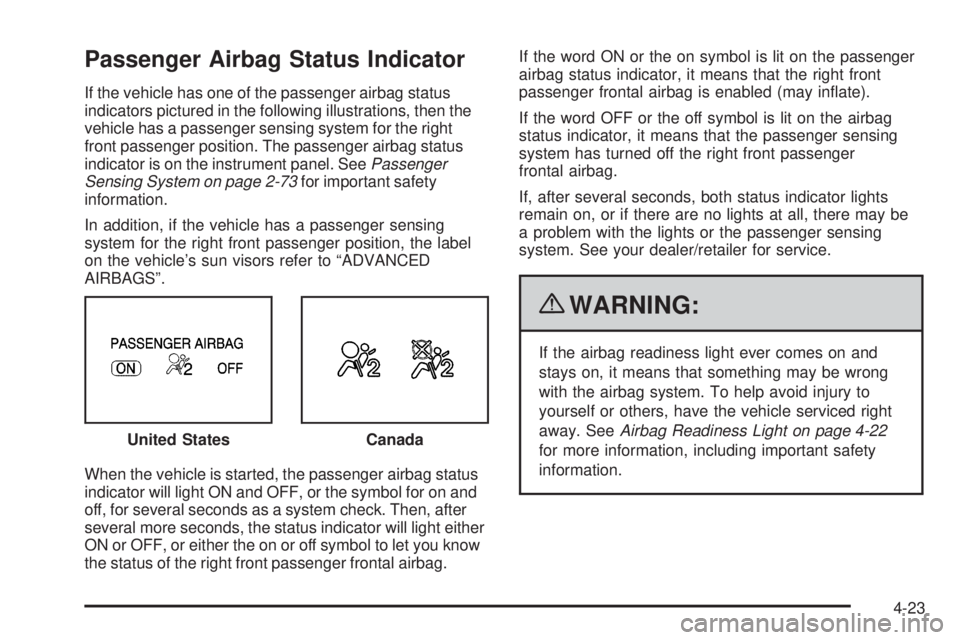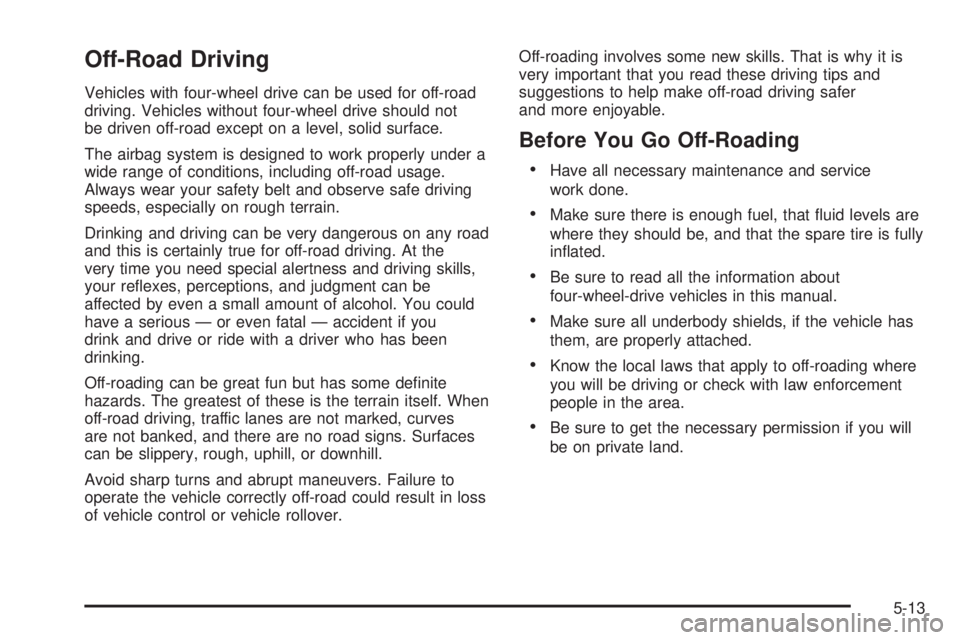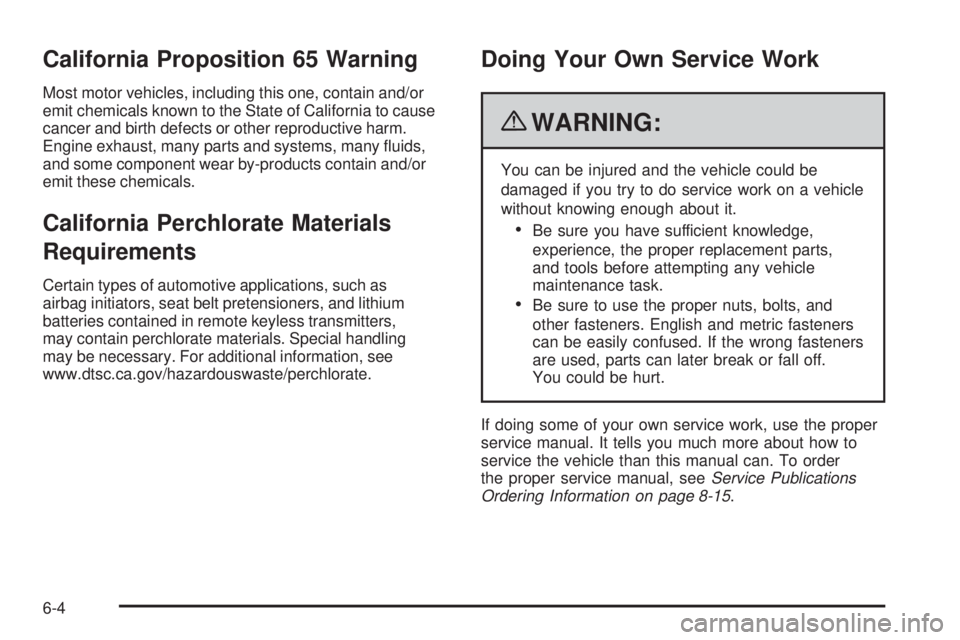2010 GMC CANYON airbag off
[x] Cancel search: airbag offPage 175 of 448

Passenger Airbag Status Indicator
If the vehicle has one of the passenger airbag status
indicators pictured in the following illustrations, then the
vehicle has a passenger sensing system for the right
front passenger position. The passenger airbag status
indicator is on the instrument panel. SeePassenger
Sensing System on page 2-73for important safety
information.
In addition, if the vehicle has a passenger sensing
system for the right front passenger position, the label
on the vehicle’s sun visors refer to “ADVANCED
AIRBAGS”.
When the vehicle is started, the passenger airbag status
indicator will light ON and OFF, or the symbol for on and
off, for several seconds as a system check. Then, after
several more seconds, the status indicator will light either
ON or OFF, or either the on or off symbol to let you know
the status of the right front passenger frontal airbag.If the word ON or the on symbol is lit on the passenger
airbag status indicator, it means that the right front
passenger frontal airbag is enabled (may inflate).
If the word OFF or the off symbol is lit on the airbag
status indicator, it means that the passenger sensing
system has turned off the right front passenger
frontal airbag.
If, after several seconds, both status indicator lights
remain on, or if there are no lights at all, there may be
a problem with the lights or the passenger sensing
system. See your dealer/retailer for service.
{WARNING:
If the airbag readiness light ever comes on and
stays on, it means that something may be wrong
with the airbag system. To help avoid injury to
yourself or others, have the vehicle serviced right
away. SeeAirbag Readiness Light on page 4-22
for more information, including important safety
information. United States
Canada
4-23
Page 229 of 448

Off-Road Driving
Vehicles with four-wheel drive can be used for off-road
driving. Vehicles without four-wheel drive should not
be driven off-road except on a level, solid surface.
The airbag system is designed to work properly under a
wide range of conditions, including off-road usage.
Always wear your safety belt and observe safe driving
speeds, especially on rough terrain.
Drinking and driving can be very dangerous on any road
and this is certainly true for off-road driving. At the
very time you need special alertness and driving skills,
your reflexes, perceptions, and judgment can be
affected by even a small amount of alcohol. You could
have a serious — or even fatal — accident if you
drink and drive or ride with a driver who has been
drinking.
Off-roading can be great fun but has some definite
hazards. The greatest of these is the terrain itself. When
off-road driving, traffic lanes are not marked, curves
are not banked, and there are no road signs. Surfaces
can be slippery, rough, uphill, or downhill.
Avoid sharp turns and abrupt maneuvers. Failure to
operate the vehicle correctly off-road could result in loss
of vehicle control or vehicle rollover.Off-roading involves some new skills. That is why it is
very important that you read these driving tips and
suggestions to help make off-road driving safer
and more enjoyable.
Before You Go Off-Roading
•Have all necessary maintenance and service
work done.
•Make sure there is enough fuel, that fluid levels are
where they should be, and that the spare tire is fully
inflated.
•Be sure to read all the information about
four-wheel-drive vehicles in this manual.
•Make sure all underbody shields, if the vehicle has
them, are properly attached.
•Know the local laws that apply to off-roading where
you will be driving or check with law enforcement
people in the area.
•Be sure to get the necessary permission if you will
be on private land.
5-13
Page 280 of 448

California Proposition 65 Warning
Most motor vehicles, including this one, contain and/or
emit chemicals known to the State of California to cause
cancer and birth defects or other reproductive harm.
Engine exhaust, many parts and systems, many fluids,
and some component wear by-products contain and/or
emit these chemicals.
California Perchlorate Materials
Requirements
Certain types of automotive applications, such as
airbag initiators, seat belt pretensioners, and lithium
batteries contained in remote keyless transmitters,
may contain perchlorate materials. Special handling
may be necessary. For additional information, see
www.dtsc.ca.gov/hazardouswaste/perchlorate.
Doing Your Own Service Work
{WARNING:
You can be injured and the vehicle could be
damaged if you try to do service work on a vehicle
without knowing enough about it.
•Be sure you have sufficient knowledge,
experience, the proper replacement parts,
and tools before attempting any vehicle
maintenance task.
•Be sure to use the proper nuts, bolts, and
other fasteners. English and metric fasteners
can be easily confused. If the wrong fasteners
are used, parts can later break or fall off.
You could be hurt.
If doing some of your own service work, use the proper
service manual. It tells you much more about how to
service the vehicle than this manual can. To order
the proper service manual, seeService Publications
Ordering Information on page 8-15.
6-4
Page 392 of 448

Fuses Usage
VSES/STOPVehicle Stability Enhancement
System/STOP
WPR Wiper
WSW Wiper/Washer Switch
Relays Usage
A/C CMPRSR Air Conditioning Compressor
BEAM SEL Beam Selection
DRL Daylight Running Lamps
FOG/LAMP Fog Lamps (If Equipped)
BK UP LP Back Up Lamp
HDLP Headlamps
HORN Horn
IGN 3 HVACIgnition 3, Climate Control,
Climate Control Head Fuse,
Power Seat Fuse
PRK/LAMPFront Parking Lamp Fuse,
Rear Parking Lamps
PWR/TRNPowertrain, Electronic Throttle
Control Fuse, Oxygen Sensor Fuse
Relays Usage
RAPRetained Accessory Power
(Power Window Fuse,
Wiper/Washer Switch Fuse),
Sunroof Fuse
RUN/CRNKRun/Crank, Airbag System Fuse,
Cruise Control Fuse, Ignition Fuse,
Back-Up Lamps, ABS Fuse, Front
Axle, PCM-1, Injectors Fuse,
Transmission Fuse, ERLS
STRTR Starter Relay (PCM Relay)
VSESVehicle Stability Enhancement
System
WPR Wipers (On/Off)
WPR 2 Wiper 2 (High/Low)
Miscellaneous Usage
A/C CLTCH Diode — Air Conditioning, Clutch
MEGA FUSE Mega Fuse
WPR Diode — Wiper
6-116
Page 429 of 448

Event Data Recorders
This vehicle has an Event Data Recorder (EDR).
The main purpose of an EDR is to record, in certain
crash or near crash-like situations, such as an airbag
deployment or hitting a road obstacle, data that will assist
in understanding how a vehicle’s systems performed.
The EDR is designed to record data related to vehicle
dynamics and safety systems for a short period of time,
typically 30 seconds or less. The EDR in this vehicle is
designed to record such data as:
•How various systems in your vehicle were operating
•Whether or not the driver and passenger safety belts
were buckled/fastened
•How far, if at all, the driver was pressing the
accelerator and/or brake pedal
•How fast the vehicle was traveling
This data can help provide a better understanding of the
circumstances in which crashes and injuries occur.Important:EDR data is recorded by your vehicle only
if a non-trivial crash situation occurs; no data is recorded
by the EDR under normal driving conditions and no
personal data (e.g., name, gender, age, and crash
location) is recorded. However, other parties, such as law
enforcement, could combine the EDR data with the type
of personally identifying data routinely acquired during a
crash investigation.
To read data recorded by an EDR, special equipment
is required, and access to the vehicle or the EDR
is needed. In addition to the vehicle manufacturer,
other parties, such as law enforcement, that have the
special equipment, can read the information if they
have access to the vehicle or the EDR.
GM will not access this data or share it with others
except: with the consent of the vehicle owner or, if the
vehicle is leased, with the consent of the lessee; in
response to an official request of police or similar
government office; as part of GM’s defense of litigation
through the discovery process; or, as required by law.
Data that GM collects or receives may also be used for
GM research needs or may be made available to others
for research purposes, where a need is shown and the
data is not tied to a specific vehicle or vehicle owner.
8-17
Page 431 of 448

A
ABS (Antilock Brake System) FAULT.................4-37
AC (Air Conditioning) OFF...............................4-37
Accessories and Modifications............................ 6-3
Accessory Power............................................3-18
Accessory Power Outlets.................................4-15
Adding Washer Fluid.......................................6-38
Additional Factors Affecting System Operation.....2-78
Additional Program Information.........................8-11
Additional Required Services.............................. 7-5
Additives, Fuel................................................. 6-6
Add-On Electrical Equipment...........................6-111
Add-On Equipment..........................................5-40
Adjusting the Speakers (Balance/Fade)..............4-48
Adjustment
Chime Level...............................................4-63
Adjustments
Headlamp Range.......................................... 2-8
After Off-Road Driving.....................................5-24
Air Cleaner/Filter, Engine.................................6-20
Air Conditioning..............................................4-16
Airbag
Adding Equipment to Your Airbag-Equipped
Vehicle...................................................2-80Airbag System
How Does an Airbag Restrain?......................2-71
Passenger Sensing System...........................2-73
Servicing Your Airbag-Equipped Vehicle..........2-79
What Makes an Airbag Inflate?......................2-71
What Will You See After an Airbag Inflates?....2-72
When Should an Airbag Inflate?....................2-69
Where Are the Airbags?...............................2-67
Airbags.........................................................2-81
Passenger Status Indicator...........................4-23
Readiness Light..........................................4-22
System Check.............................................2-64
All Overseas Locations...................................... 8-6
AM ...............................................................4-62
AM-FM Radio.................................................4-43
Antenna
Fixed Mast.................................................
4-63
Antenna, XM™ Satellite Radio Antenna System.....4-63
Antilock Brake System (ABS)............................. 5-5
Warning Light.............................................4-26
Appearance Care
Aluminum or Chrome-Plated Wheels.............6-108
Care of Safety Belts...................................6-105
Chemical Paint Spotting..............................6-109
Cleaning Exterior Lamps/Lenses..................6-106
Fabric/Carpet............................................6-103
Finish Care...............................................6-107
1
Page 439 of 448

J
Jump Starting.................................................6-43
K
Keyless Entry
Remote (RKE) System................................... 3-3
Keyless Entry System....................................... 3-3
Keys............................................................... 3-2
L
Labeling, Tire Sidewall.....................................6-58
Lamps
Daytime Running (DRL)................................4-11
Dome ........................................................4-13
Dome Lamp Override...................................4-14
Exterior Cargo.............................................4-13
License Plate..............................................6-54
Malfunction Indicator....................................4-28
Lap Belt........................................................2-33
Lap-Shoulder Belt...........................................2-27
LATCH System for Child Restraints...................2-46
Latches, Seatback............................................ 2-9
Leaving After Parking on a Hill.........................5-59Leaving the Vehicle With the Engine Running
(Automatic Transmission)..............................3-32
Lighting
Exit...........................................................4-14
Lights
Airbag Readiness........................................4-22
Antilock Brake System (ABS) Warning............4-26
Brake System Warning.................................4-25
Charging System.........................................4-24
Cruise Control.............................................4-32
Exterior Lamps............................................4-10
Flash-to-Pass............................................... 4-5
Highbeam On.............................................4-32
High/Low Beam Changer................................ 4-5
Oil Pressure...............................................4-31
On Reminder..............................................4-11
Passenger Airbag Status Indicator..................4-23
Safety Belt Reminders..................................4-21
Security.....................................................4-32
StabiliTrak
®/Traction Control System (TCS)
Warning Light..........................................4-26
Tire Pressure..............................................4-28
Up-Shift.....................................................4-24
Limited-Slip Rear Axle....................................... 5-9
Loading Your Vehicle.......................................5-33
Loading Your Vehicle for Off-Road Driving..........5-14
9
Page 441 of 448

O
Odometer......................................................4-20
Trip ...........................................................4-20
Off-Road .......................................................5-13
Driving.......................................................5-13
Recovery....................................................5-11
OIL ...............................................................4-39
Oil
Engine.......................................................6-15
Engine Oil Life System.................................6-18
Pressure Light.............................................4-31
Older Children, Restraints................................2-35
Online Owner Center........................................ 8-5
Online Owner Center
(U.S.) — www.gmownercenter.com/gmc............ 8-5
OnStar, Privacy..............................................8-18
Other Rainy Weather Tips................................5-26
Outlet Adjustment............................................4-18
Outlets
Accessory Power.........................................4-15
Outside
Convex Mirror.............................................3-39
Manual Mirrors............................................3-38
Power Mirrors.............................................3-38
Owner Checks and Services.............................. 7-8
Owner Information...........................................8-15
Owners, Canadian.............................................. iii
P
Paint, Damage..............................................6-109
Park
Shifting Into................................................3-31
Shifting Out of............................................3-32
PARK BRK (Brake).........................................4-39
Parking
Brake........................................................3-30
Over Things That Burn.................................3-33
Parking Brake and Automatic Transmission
P (Park) Mechanism Check............................. 7-9
Parking on Hills..............................................5-58
Parking Your Vehicle.......................................3-33
Passenger Airbag Status Indicator.....................4-23
Passenger Safety Belt Reminder Light...............4-21
Passenger Sensing System..............................2-73
Passing.................................................5-11, 5-57
PASS-Key
®III+ Electronic Immobilizer...............3-15
PASS-Key®III+ Electronic Immobilizer
Operation...................................................3-15
Passlock
®......................................................3-14
Perchlorate Materials Requirements, California...... 6-4
Personalization Features..................................4-34
Pickup Conversion to Chassis Cab....................5-40
Playing a CD (Radio with Single CD Player).......4-52
Playing an MP3/WMA CD-R Disc......................4-55
Playing the Radio...........................................4-45
11